Vol 4 No. 8 TROPIC LIGHTNING NEWS February 24, 1969
Index
Cav
Battle In Boi Loi Woods
Blasts NVA Near Go Dau Ha
CU CHI - In one day of
ferocious fighting in the Boi Loi Woods, 6 miles southwest of Go Dau Ha, the 3d
Squadron, 4th Cavalry killed 46 NVA and delivered a severe blow to an estimated
enemy company.
At 7:30 in the morning, A
and C troops moved out of their night laager and began to sweep towards an area
with heavy underbrush. The two
troops had walked about a hundred yards when they found bunkers.
Infantrymen riding on the
tracks dismounted to search the bunkers which they found were interconnected by
tunnels.
Suddenly the enemy opened up
with machinegun and rifle fire, grenades and RPGs slammed into the troopers from
the woodline.
Two medics, Specialist 4
Charles H. Jones, Tarkio, Mo., and Specialist 4 James B. O’Keefe, Columbus,
Ohio, ran from track to track, treating the wounded while bullets whizzed around
them.
The armored troopers
regrouped. An RPG hit the track of
Staff Sergeant Tommy Brewingon, Fayetteville, N.C.
He pulled two men out and then refused to leave until everyone had begun
moving out of the area. The
troopers returned to their night laager position, but still more sporadic sniper
fire cracked while the dustoff choppers flew in and out.
B Troop, which had also come
under fire off A and C Troop’s right flank, joined the two troops to launch an
attack on the entrenched NVA positions. This
time the Horsemen decided to attack the enemy on their flank, using a dirt road
that circled to he left. As they
proceeded, the armored column came under intense fire again. Enemy bunkers lined
the whole stretch of road. The
Troopers fought back with everything they had.
The bunkers were silenced with fire from the tanks’ 90mm guns shooting
at close range as fast as rounds could be loaded, fired and the shells
extracted.
Each tank’s machineguns,
and the .50 caliber machineguns on the APC’s plus their M-60 machineguns, and
M-16 rifle fire ripped into the enemy positions.
A hand grenade lobbed out of
one of the enemy bunkers landed on the road between two tracks and exploded.
Captain Melvyn Moss of Kingston, N.Y., commander of A Troop, was riding
on one of the tracks when the grenade blew.
He pulled the pin on one of his grenades and threw it into the bunker.
The NVA soldier in the
bunker threw it back and it exploded in (Continued on Back Page)
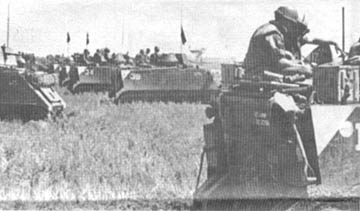 |
| FORMING A SOLID FRONT of steel, tracks of the 3d Squadron, 4th Cavalry, line up in preparation for a sweep toward Charlie’s bunkers on an operation near the Cambodian border. |
2-34
Tanks Mop Up NVA
CU CHI - Second brigade
tankers from Company A, 2nd Battalion, 34th Armor, moving in after a tactical
air strike, recovered the bodies of 13 NVA soldiers.
The strike and the sweep took place in the Filhol Plantation northeast of
Cu Chi.
The bodies were found in and
around a series of recently evacuated tunnel complexes.
The Dreadnaught force also uncovered 11 individual weapons, documents,
ammunition and explosives in the area near the 25th’s base camp.
One wounded NVA soldier was
hiding in a tunnel. Before he could
be removed from the tunnel for treatment, the NVA pulled out a hidden grenade.
It exploded and killed him instantly.
Hornets
& ‘Hounds Harass Viet Cong
CU CHI
- Second Brigade
soldiers from the 2d Battalion, 27th Infantry Wolfhounds joined forces with
Hornet gunships to kill three VC and detain one suspect.
The soldiers had just
touched down when the Hornets of the 269th Assault Helicopter Company, covering
them, spotted several VC about 800 meters south of them. The gunships engaged the VC and the Bravo Company Wolfhounds
quickly moved forward to block any VC trying to escape.
“We moved into the area of
contact right after the gunships had finished working it over,” recalled First
Lieutenant Donald Miller, Virginia Beach, Va., the company executive officer.
“There were signs of fresh VC activity in the area so we took it slow,
checking out everything.”
The Wolfhounds found two VC
killed by the gunships and another had been wounded.
The wounded man was patched up and evacuated for treatment.
Several items of VC clothing
and documents were also found in the immediate area. “Our Kit Carson got
excited all of a sudden when he found a little trail leading into thick
underbrush,” said Sergeant Calvin Cosper, Colgate, Okla.
The scout kept saying “beaucoup VC, beaucoup VC,” so I put up some
security and we went in to search the thicket.”
Specialist 4 Eddie Thomas,
Tupelo, Miss., added, “The trail led us near a trap door that showed signs of
recent use, so we figured the VC were in there.”
Cosper posted Thomas as
security and prepared to throw a grenade into the hole.
As he lifted the cover, a flurry of bullets came from the hole.
The cornered VC opened up with his AK.
As the two men prepared
again to throw the grenade, the VC poked his head out of the hole and prepared
to throw a grenade of his own.
Thomas was ready, however
and shot the VC before he could throw the grenade.
He dropped it back into his hole. It
exploded and killed him instantly.
A Kit Carson scout then
entered the tunnel to search it out. He
came up with a 9mm pistol, an AK-47, two flashlights and several documents.
Cosper later found that the
AK rounds coming from the hole had come pretty close - his steel pot had two
dents in it that weren’t there when the sweep began.
“I was lucky,” Cosper
said after the experience, “I always wanted to find one of those VC trap
doors, but I never thought it would be like this.”
 |
| DURING A LULL in the fighting, the Cav troopers rest deep in the Boi Loi’s jungle. (PHOTOS BY SP4 ROBINSON TRUITT) |
Fire
Brigade’s Warriors Throw Back VC Assault
CU CHI
- Two platoons of
Tropic Lightning soldiers from the Fire Brigade’s 2d Battalion, 12th Infantry,
beat back a fierce ground assault in a one and one-half hour battle eight miles
northwest of Cu Chi.
With two squad-sized ambush
patrols thrust into the darkness in hope of intercepting a Viet Cong supply
element thought to be operating in the Trang Bang area, the Bravo Company
Warriors watched the night from their dug-in laager.
In the early morning, the VC
rained a heavy barrage of mortar and rifle grenade rounds on the Americans.
The artillery
attack was followed closely by a ground attack by an estimated enemy platoon.
“They hit us with heavy
small arms and RPG fire. They
seemed to be shooting from everywhere,” said First Lieutenant Jeffrey Tidd of
Cambridge, Ohio.
Even through U.S. artillery
and gunship support the Viet Cong advanced, but their rush was checked in the
last few meters by a fierce return of fire from the warriors.
“They got close,” Tidd
said. “The next morning we found an AK magazine atop a rice paddy dike that
formed part of our perimeter.”
While the Warriors fought
for their lives at the night location killing eleven of the enemy, one of the
outlying patrols sprung its ambush killing two more.
| There is no substitute for a safety conscious GI. We in Vietnam face danger from ourselves as well as good ol’ Chuck. Careless drivers or a haphazard rifleman can be just as dangerous as the enemy. There are enough hazards over here as it is. Take stock of yourself and wise up to safety in everything you do. It’s healthy that way! |
Page 2 TROPIC LIGHTNING NEWS February 24, 1969
Decorated
| LTC Clemens A. Riley, HHT, 3d Sqdn, 4th Cav LTC Clifford C. Neilson, HHC, 4th Bn, 23d Inf CPT John W. Knox, A Btry, 7th Bn, 11th Arty 1LT Johnnie R. Goodwin, C Co, 1st Bn, 5th Inf 1LT Christopher Brown, D Co, 3d Bn, 22d Inf LT Marshall C. Walla, Jr., Co A, 1st Bn, 5th Inf 1LT Arthur B. Cook, Jr., A Co, 1st Bn, 5th Inf 1LT William D. McMonagle, HHC, Div 1LT David R. Lunn, D Co, 2d Bn, 14th Inf CSM Robert Adams, HHC, 3d Bn, 22d Inf SSG Richard Hautekeete, B Co, 1st Bn, 5th Inf SSG Johnny L. Porter, A Btry, 3d Bn, 13th Arty SSG Ezrv G. Hamm, A Btry, 3d Bn, 13th Arty SSG Louis Ibarra, A Btry, 3d Bn, 13th Arty SGT Eugene F. Medford, E Co, 2d Bn, 27th Inf SGT Daniel King, B Trp, 3d Sqdn, 4th Cav SGT Richard C. Judnich, A Co, 1st Bn, 5th Inf SP4 Marvin R. Gillming, B Co, 1st Bn, 5th Inf SP4 Thomas Short, Co C, 3d Bn, 22d Inf SP4 Victor Short, A Btry, 3d Bn, 13th Arty SP4 Morris T. Perkins, C Trp, 3d Sqdn, 4th Cav SP4 Robert E. Drye, Co B, 2d Bn, 12th Inf SP4 James Selle, Co D, 3d Bn, 22d Inf SP4 Dennis J. Kuehler, A Trp, 3d Sqdn, 4th Cav |
SP4 Kenneth I. Frye, Co B, 2d Bn, 12th Inf SP4 Lindel L. Walker, A Trp, 3d Sqdn, 4th Cav SP4 Armand J. Fleury, B Co, 1st Bn, 5th Inf SP4 Rafael Ontiveros, Jr., B Co, 2d Bn, 12th Inf SP4 Michael Koteski, E Co, 2d Bn, 27th Inf SP4 Michael Ringenberg, E Co, 2d Bn, 27th Inf SP4 Richerd D. Israels, E Co, 2d Bn, 27th Inf SP4 Harry A. Watson, A Trp, 3d Sqdn, 4th Cav SP4 James D. Warren, A Co, 1st Bn, 5th Inf SP4 Thomas Eason, 25th Admin Co SP4 Daniel Mullins, D Co, 3d Bn, 22d Inf SP4 Douglas C. Blood, B Co, lst Bn, 5th Inf SP4 Simon Contreras, A Btry, 3d Bn, 13th Arty PFC Dennis Bealka, Co D, 3d Bn, 22d Inf PFC Art Lawrence, Co D, 3d Bn, 22d Inf PFC Lloyd Burkholder, Co C, 3d Bn, 22d Inf; PFC James A. Brown, Co B, 4th Bn, 23d Inf PFC Jim Rogers, Co C, 3d Bn, 22d Inf PFC Robert Searfoss, Co D, 3d Bn, 22d Inf PFC Robert Anglin, Co D, 3d Bn, 22d Inf PFC Serrano Velez, Co D, 3d Bn, 22d Inf PFC Norbert C. Urbanski, Co D, 3d Bn, 22d Inf PFC Alfred D. Smith, C Trp, 3d Sqdn, 4th Cav |
Tropic Lightning Tots
The Commanding General Welcomes
The Following Tropic Lightning Tots
To The 25th Infantry Division – As
Reported By The American Red Cross.
Born To:
| Feb. 1 SSG Robert O. Peterson, D Btry, 3d Bn, 13th Arty, a daughter Feb. 2 PFC Rubin N. Beavers, A Co, 2d Bn, 34th Armor, a son PFC Rodney B. Caesar, A Btry, 1st Bn, 8th Arty, a son Feb. 3 PFC David Fulks, A Co, 2d Bn, 34th Armor, a daughter Feb. 4 SP4 William Phagen, 25th Admin Co, twin sons SP5 Robert A. Brady, D Trp, 3d Sqdn, 4th Cav, a daughter |
Feb. 4 SP4 Patros Scaris, B Btry, 3d Bn, 13th Arty, a daughter Feb. 6 CPT James M. Shuke, 40th Med Det. (KJ), a daughter SP4 Ralph D. Hanna, B Trp, 3d Sqdn, 4th Cav, a son PVT Thomas E. Arney, Co. C, 25th Med Bn, a daughter Feb. 9 1LT Jack M. Giles A Btry, 3d Bn, 13th Arty, a daughter SP4 Larry C. Vallelonga, A Trp, 3d Sqdn, 4th Cav, a son |
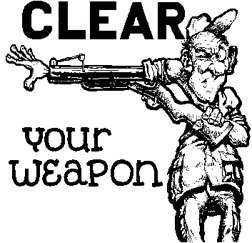 |
WHEN YOU’RE NOT using that weapon, make sure lt’s cleared! Don’t risk your life and your buddies’ lives. Clear your weapon by checking the chamber. THINK SAFETY ALWAYS. |
Responsibility
of Service Is Partial Payment For Freedom
The right and obligation of
Americans to defend themselves and their way of life has been recognized from
earliest colonial times.
During the revolutionary
War, training and discipline varied greatly from county to county, and state to
state, but the responsibility to bear arms in the defense of the common good was
recognized by all.
This recognition stemmed
from the understanding that men must be responsible if they are to be free.
Under our democratic system
of government, the majority make the laws, but are also responsible for
protecting the rights of minority groups. By
the same token, each minority group obeys these laws, whether it agrees with
them or not, but works responsibly to insure that its views and unique needs are
expressed and understood by the majority.
Thomas Jefferson wrote, “.
. . though the will of the majority is in all cases to prevail, that will, to be
rightful, must be reasonable; the minority possess their equal rights, which
equal laws must protect....”
Since Jefferson wrote this,
our experience has shown that the members of the minority must proclaim their
wants and needs. Otherwise, the
majority may lack the knowledge to adequately consider the minority when it
makes laws affecting all citizens.
In the early days of our
country there were some Americans who wanted unrestrained freedom without
responsibilities.
Thoreau, for example,
insisted that a man ought to pay taxes only for those government projects or
military operations which he personally approved.
Most Americans, although
understanding his feelings, have enough common sense to know that his approach,
carried to the extreme, would quickly ruin the government.
An individual who has voted
against putting a traffic signal at a busy intersection is still obliged to obey
that signal. Ignoring it would
endanger his life and that of his neighbor.
Similarly, the majority of
Americans has recognized the requirement for military forces to defend our
nation. Elaborate procedures have
been established to assure that the laws are administered equally and justly.
The law requiring military
service was established to protect the freedom of all Americans, not just the
majority. For this reason, every
citizen has a responsibility to serve when called upon to do so.
Those who accept this responsibility contribute to America and all that
it stands for.
What all Americans seek -
our vision of the future - is a world at peace.
To achieve that vision, we
must recognize that the difficult task of building bridges of peaceful
cooperation with those who would be our enemies must go hand in hand with the
hard, costly and sometimes bloody defense of freedom.
Former President Johnson has
clearly stated the challenge that confronts America.
“. . . human misery and vaulting ambitions combine to threaten peace
and security in the world. Much of
our effort must be devoted to preventing the forces of aggression from asserting
themselves or dealing with them when they do.”
Tropic
Lightning
Combat Honor Roll
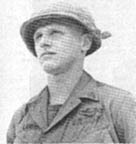 Specialist 4 Julian G.
Gamache distinguished himself by heroic actions on December 18 1968, while
serving as a track driver with Company A, 1st Battalion, 5th Infantry.
Specialist 4 Julian G.
Gamache distinguished himself by heroic actions on December 18 1968, while
serving as a track driver with Company A, 1st Battalion, 5th Infantry.
While on a reconnaissance in
force mission, Company A came under a massive communist attack.
During the initial contact,
two tracks were struck by several RPG rounds, wounding the occupants.
With complete disregard for his own safety, Gamache maneuvered his track
through the bullet-swept area to the disabled vehicles and immediately entered
the first track.
Extracting the driver, he
drove the now flaming armored carrier to a safe position in the rear.
Dauntlessly he again exposed
himself to the deadly Viet Cong fire as he advanced to the second track, mounted
it and proceeded to retrieve the personnel carrier.
Gamache continued in this
heroic manner for the duration of the fierce battle.
His valorous actions
contributed immeasurably to the recovery of the valuable equipment and the
defeat of the insurgent force.
His personal bravery,
aggressiveness and devotion to duty are in keeping with the highest traditions
of the military service and reflect great credit upon himself, his unit, the
25th Infantry Division and the United States Army.
The TROPIC LIGHTNING NEWS is an authorized publication of the 25th Infantry Division. It is published weekly for all division units in the Republic of Vietnam by the Information Office, 25th Infantry Division, APO San Francisco 96225. Army News Features, Army Photo Features, Armed Forces Press Service and Armed Forces News Bureau material are used. Views and opinions expressed are not necessarily those of the Department of the Army. Printed in Tokyo, Japan, by Pacific Stars and Stripes.
MG Ellis W. Williamson . . . . Commanding General
MAJ John C. Fairbank . . . . . Information Officer
2LT Don A. Eriksson . . . . . . Officer-in-Charge
SP4 Stephen Lochen . . . . . . Editor
SP4 Jim Brayer . . . . . . . . . . . . Assistant Editor
SP4 Robert C. Imler . . . . . . . . Production Supervisor
Page 3 TROPIC LIGHTNING NEWS February 24, 1969
Mole
City Gets Facelift Job Resulting In FSB Sedgwick
TAY NINH - Not letting
success stand in the way of progress, the 4th Battalion, 9th Infantry Manchus
have enlarged and improved their battle-tested Mole City outpost.
Mole City is the aptly named
underground fortress from which troops of the 1st Brigade socked it to an
estimated North Vietnamese regiment that tried a midnight attack December 21.
During the night-long battle 106 enemy died.
Manchu commander Lieutenant
Colonel Leo L. Wilson of Salina, Kans., and his Bravo and Charlie companies
wanted to hang on to their hard-won plot of ground 16 miles southeast of Tay
Ninh near the Cambodian border. And
they weren’t about to stand pat.
“We considered moving the
base to several other sites, but after further study decided that Mole City
meets all our requirements,” Wilson said.
“In addition to that, this is ground we’ve bought with hard fighting,
and we have that much more reason to want to hold it.”
With hard work and
cooperation between forward and rear elements, the “rural renewal” of Mole
City was accomplished quickly. In
ten hours, 12 Chinook and eight Super-Crane helicopter sorties hauled in
building materials, supplementing the 27 sorties needed for the first
installation.
In the renovation process
Mole City received:
- A population increase and
additional artillery fire power;
- A promotion in label and a
name change from Patrol Base Mole City to Fire Support Base Sedgwick;
- A facelifting that
included extending the perimeter and knocking down palm trees that were in the
artillery line of fire.
All this required most of
the Manchus of Mole City to leave bunkers they’d been working on for three
weeks and dig new ones, but they took the move philosophically.
“It’s a lot of work, but
it’ll be worth it because we’re getting more firepower in here,” said
Private First Class Clifton E. White of Vici, Okla.
“When something has to be done, and you know there’s a good reason
for it, you don’t mind working.”
Specialist 4 Henry F.
Wilson, Nespelem, Wash., saw the move as a chance for some architectural
improvement.
Surveying his newly dug and
covered bunker, he said, “This one looks a lot better than my old one.
Now we’ve got protection and beauty, too!”
 |
RURAL DEVELOPMENT – Three men from Charlie Company of the 4th Battalion, 9th Infantry Manchus work here as Patrol Base Mole City is transformed into Fire Support Base Sedgwick. In the hole is Specialist 4 George L. Liptak of Cleveland, while Privates First Class Bill J. Ozanich of Manistique, Mich. (left) and Orville P. Millarr of Tulsa, toil on the upper level of their new home. (PHOTO BY PFC RALPH S. NOVAK) | |
| MOVING THE FURNITURE – Men of Charlie Company of the 4th Battalion, 9th Infantry load a trailer with sandbags nd steel sheets that went into the new bunkers they dug along the perimeter at the new Fire Support Base Sedgwick. (PHOTO BY PFC RALPH S. NOVAK) |  |
Radio
Jargon Confusing, Amusing; Over
By SP4 Dave DeMauro
CU CHI - Radio call signs
accompanied by complicated jargon have proved to be confusing but amusing.
Newcomers arriving in country find themselves baffled with radio
transmissions until they become accustomed to the code.
With this problem licked,
you get another call from ‘Flashbulb Six’ requesting you to rush him more
film. Ah ha!
No problem - ‘Flashbulb Six’ is some colonel out taking flicks with
his trusty 120. You find out later
that ‘Flashbulb Six’ is the public information officer needing film to
photograph combat scenes. Good Old
‘Flashbulb Six.’
Now you’re beginning to
get confident. You’ve got the
situation well in hand. Then you
get a call from ‘Big Shot’ (brigade commander).
‘Big Shot’ has a lot to say and wastes no time saying it. Here’s what the conversation sounds like:
“Bewildered (that’s you)
this is Big Shot. I’ll arrive your location 2000 hours.
Have Fat One (the cook) prepare dinner for ten.
Inform Alka Sizer (the medical operations officer) that tomorrow’s
MEDCAP is go! Tell Hungry Eye (a
reconnaissance chopper) his mission starts 2330 hours.
Fire Power (gunships) will accompany Hungry Eye.
Ulcer three (the combat operations officer) will report to me
tomorrow’s ball game. This is Big Shot - OUT!!”
So poor ‘Bewildered,’
what do you do? Xin Loi!!!
Infantry,
Viets Snuff Michelin Plantation Fire
DAU TIENG - American
infantrymen and Vietnamese from Dau Tieng village fought side by side to snuff
out a major fire which threatened the economic life of the community.
The blaze broke out shortly
after 9 p.m. in the sprawling Michelin rubber factory, 45 miles northwest of
Saigon.
Colonel Louis J. Schelter of
Columbus, Ga., commander of the 3d Brigade, committed his resources when it was
apparent the Vietnamese would not be able to contain the flames.
Volunteers from two infantry
battalions, numerous support units and the 142d Engineers Detachment (Fire
Fighters), backed up by armored personnel carriers and military police
machinegun jeeps, went to the scene of the fire.
“It looked as if we might
not be able to bring it under control,” said Sergeant Jack McGee of Chicago,
head of the firefighters. “When
we got there the flames were soaring almost 70 feet in the air.”
Two water trucks from the
rubber plantation were feebly attempting to keep pace with the inferno.
Vietnamese workers and
Popular Forces soldiers from Tri Tam district were on the scene when the GIs
arrived.
As the brigade commander
flew overhead in his command and control helicopter directing the operation, all
available tank trucks from Dau Tieng base camp provided water for the
firefighters.
Two walls collapsed as
buildings adjoining the blaze were threatened . The firefighters poured more
than 20,000 gallons of water onto the fire before bringing it under control
shortly before midnight.
The intense heat of the fire
was blamed on more than 60 tons of high grade rubber which burned, sending
clouds of acrid smoke billowing into the night.
The heat melted steel beams and a tin roof.
An unofficial source
attributed the blaze to an electrical short circuit in machinery which operates
a series of heated curing ovens at the conclusion of processing.
Damage was estimated at more
than 400,000 piasters (about $35,000), mostly in damage to the building and
machinery.
“There is no way to
describe the gratitude of these people for the job these soldiers did,” said
Major Lawrence P. Kenney Jr. of Hancock, N.Y., advisor to Tri Tam district.
“The loss of this factory
would have been a catastrophe. It
employs more than 1,000 workers and is virtually the only industry in this
area.”
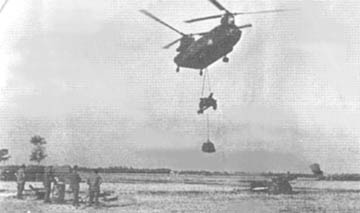 |
| IN-COMING - A Chinook gently lowers one of the 105 mm howitzers flown in to bo1ster the defense of the 4th Battalion, 9th Infantry’s Fire Support Base Sedgwick (PHOTO BY PFC RALPH S NOVAK) |
Page 4-5 TROPIC LIGHTNING NEWS February 24, 1969
Tropic Lightning Keeps The Heat On
 |
THE FACE OF BATTLE – Specialist 4 Paul Obholz of Chicago, Ill., pauses before tossing another grenade into a dug-in enemy position. Specialist 4 Don King of Cleveland looks on as the Golden Dragons engaged the enemy near Cu Chi. (PHOTO BY SP4 E.R. JAMES) | |
|
CAPTURED SAMPAN – Wolfhounds ride through a swampy area northwest of Saigon in a sampan. The soldiers found the VC boat during a sweep through the marshy country. (PHOTO BY SP4 R.B. WILLIAMS)
|
 |
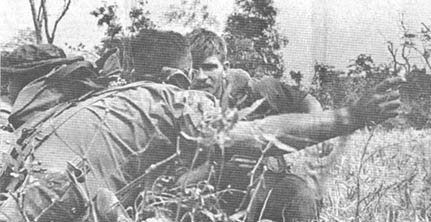 |
| DIRECTING THE ATTACK – After making a heliborne assault of an enemy-infested hedgerow, Captain Wilbur Corbitt of Lake City, Fla., commander of B Company, 2d Battalion, 14th Infantry, positions his troops. Specialist 4 Patrick McMullen, of Fremont, Calif., receives instructions on flushing out the enemy as the troops prepare to move in. (PHOTO BY SP4 E.R. JAMES) |
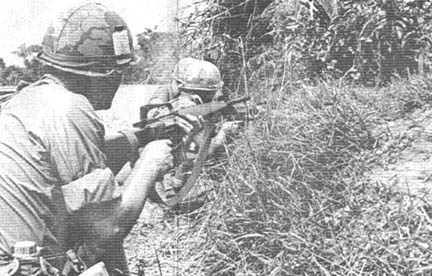 |
|
ALERTED TO MOVEMENT in the brush, Tropic Lightning soldiers of B Company, 2d Battalion, 14th Infantry Golden Dragons prepare to place fire on the well-camouflaged VC. (PHOTO BY SP4 E.R. JAMES) |
 |
IN DANGEROUS PROXIMITY to a camouflaged VC position, Specialist 4 Phillip Amsden, Riverdale, Ill., of B Company, 2d Battalion, 14th Infantry prepares to blast the enemy with his M-79. The fire fight took place northwest of Saigon. (PHOTO BY SP4 E.R. JAMES) | |
| WATCHING while artillery pounds a VC target, a rifleman from Delta Company, 2d Battalion, 27th Infantry waits in the treeline. The 2d Brigade troops were on a search-and-clear mission northwest of Saigon. (PHOTO BY SP4 R.B. WILLIAMS) | 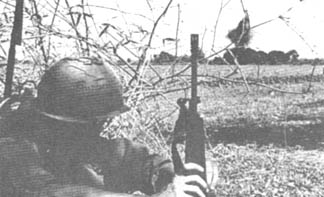 |
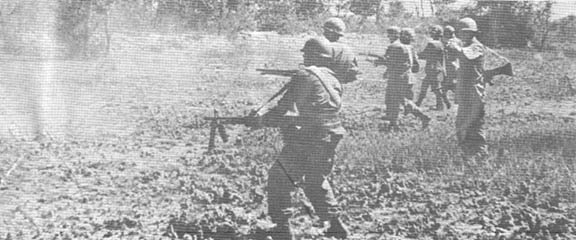 |
| RECON BY FIRE – Tropic Lightning soldiers from C Company, 4th Battalion (Mechanized) 23rd Infantry, perform a reconnaissance by fire into an area where an NVA bunker complex was found. The action took place ten miles east of Tay Ninh City. (PHOTO BY SP4 ROGER WELT) |
|
POUNDING CONG TARGETS – Grenadiers from Delta Company, 2d Battalion, 27th Infantry Wolfhounds recon a thick hedgerow near the battalion’s Fire Support Base Reed. The 2d Brigade soldiers were operating in search of suspected NVA forces. (PHOTO BY SP4 ROBERT WILLIAMS) |
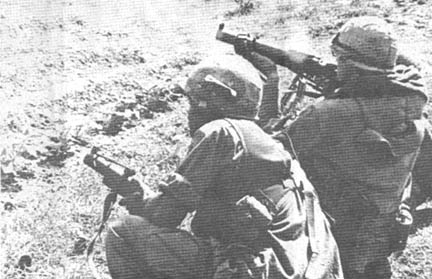 |
Page 6 TROPIC LIGHTNING NEWS February 24, 1969
Regular
Recon Prowls Terrain
TAY NINH - Providing rapid
and reliable reconnaissance for the 3d Battalion, 22d Infantry is the job of the
Regulars reconnaissance patrol. Daily
the patrol covers the area surrounding Fire Support Base Buell north of Tay Ninh,
conducting visual reconnaissance and terrain analysis missions.
Frequently, the recon team
works with the Vietnamese National Police.
Specialist 4 William Billiot
of Lafitte, La. (who is referred to as “Short Round” by his companions), has
completed Tunnel Rat School and searches all underground structures the unit
finds.
“Because I’m smaller
that the other guys, I was always elected to inspect every hole we found,”
said Billiot. “So I decided that
I had better know what I’m doing. I
asked for an appointment to attend Tunnel Rat School.
Now I’m the official tunnel rat of the patrol.”
Sergeant George M. Turajlich
of Cupertino, Calif., and Sergeant Scott Anderson of Balsin Lake, Wisc., have
attended the U.S. Army Special Forces-operated Recondo School in Nha Trang.
Undergoing three weeks of strenuous physical training along with
reconnaissance training, these two Tropic Lightning soldiers are well qualified
to conduct reconnaissance missions. They
have shared their knowledge with the other team members to make their operation
“just that much better.”
Dressed in camouflaged
fatigues and soft caps, the team scouts look for signs of enemy preparations for
attack. Each member knows the
terrain and exactly what to look for.
The force is led by Staff
Sergeant Floyd E. Huff of Pascagola, Miss.
“We’re forever probing into brush or any other feature which may be
used to store weapons or supplies,” said Huff.
At present the patrol is
attempting to acquire two small aluminum boats to probe river banks for enemy
caches. “We know the enemy uses
waterways to transport his goods. The
thick vegetation along the waterways offers ideal hiding places to conceal
weapons and supplies. The boats
would enable us to cover the banks and search them much faster than swimming or
wading,” said Huff.
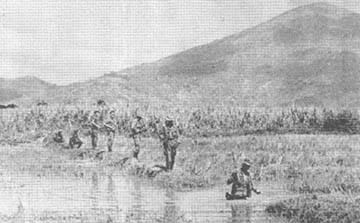 |
|
OOZING THROUGH a natural waterway in the shadows of Nui Ba Den Mountain are members of the Reconnaissance patrol. Leading the file is Specialist 4 Charles Leitzmen of Martinsville, Ind. The Tropic Lightning team is part of the 3d Battalion, 22d Infantry. (PHOTO BY SP4 DAVID DEMAURO) |
Hoi
Chanh Rallier Surprises Bobcats
CU CHI - A former Viet Cong
who decided to rally under the Chieu Hoi program gave Staff Sergeant James R.
Logan of Silver Springs, Md., an unusual tale to tell near the end of his tour
in Vietnam.
Recently Logan, Company B,
1st Battalion (Mechanized), 5th Infantry, was supervising a bunker repair detail
near Cu Chi’s Ann Margaret gate when he noticed a man waving to him in the
distance.
Logan explained, “I had
just stepped outside the bunker when I spotted a man about 600 meters out
signaling to me with his arms.”
The 2d Brigade soldier said
the man was barefooted, wearing a black cotton T-shirt with black pajama
trousers.
“I noticed him begin to
walk forward; he seemed a bit uncertain,” Logan continued.
The Hoi Chanh was prompted
to rally by an airdropped leaflet emphasizing the advantages of Chieu Hoi
living, which he held above his head.
As it turned out, Logan
lived up to what was described on the leaflet.
After walking across several meters of open field, the former enemy,
still clutching the leaflet, used a three-foot board to scale the five rows of
concertina wire in front of the bunkers where Logan greeted him.
Private First Class David
Gentile, Oklahoma City, and Sergeant Monte Smart, Milo, Maine, were there also,
and the three Tropic Lightning soldiers drove the ex-VC to the Chieu Hoi center.
At the center, through an
interpreter, it was learned that the Hoi Chanh had left his Viet Cong unit near
Trung Lap - where he said he was forced to fight.
He also said that he brought
a weapon that he left near the site where he was initially spotted.
Later in the day, First
Lieutenant Michael Idol, Los Angeles, with the aid of Specialists 4 Dennis
Leuwerke, Garner, Iowa, and Jesse Graig, Benton, Ill., all from the Bobcats C
Company, made a search of the area and found a perfectly maintained AK47.
Idol remarked, “The area
was so wet and heavily covered with wire that it’s amazing the man could have
made the walk in such a short time.”
‘Hound
Ambush Works
CU CHI – A Charlie
Company, 2d Battalion, 27th Infantry Wolfhound ambush resulted in one
enemy soldier killed and one captured AK-47.
The 1st Platoon had just set
up their ambush behind a rice paddy dike facing a road when they spotted
movement. The platoon medic,
Specialist 4 Robert Wolff, Elgin, Ill., recalled, “Instead of coming down the
road like we had expected, the VC were moving through a marshy area to our
rear.”
The 2d Brigade soldiers
repositioned and waited for the enemy to come into range.
“We kept an eye on
them,” said Specialist 4 Tony Orr, Robinsville, N.C., “and also watched the
road.”
Again the Wolfhounds
repositioned.
“The two VC stopped on the
road,” related Orr. “I was sure they saw us.”
“I was trying to get the
men organized after the last move,” said Sergeant Jimmy Phillips, Muncie, Ind.
“Finally I couldn’t wait any longer.
I opened up with my M-16.”
After a brief exchange of
fire all was quiet. The contact had
alerted the VC in the swamp who now moved up on the patrol. Immediately artillery was called in on the enemy who
scattered for safety.
The platoon spent the night
watching for the enemy’s return.
2-34
Finds Ammo Cache
CU CHI
- Second Brigade
soldiers from the Battalion, 34th Armor uncovered a munitions cache southwest of
Phu Hoa Dong. The Tropic Lightning
troopers found one case of AK rounds, one Chicom antitank mine, one 60mm mortar,
ten B-40 rockets and two RPG2 rounds encased in plastic.
The complex itself had
crawlways about four feet high and two rooms six feet high. After the munitions were removed, the complex was destroyed.
A further search of the area
disclosed the shallow graves of two VC. The
graves were approximately three days old.
Page 7 TROPIC LIGHTNING NEWS February 24, 1969
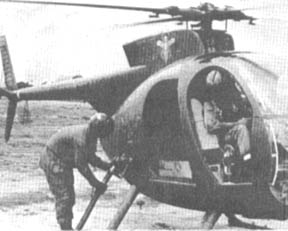 |
FILL ‘ER UP - Specialist 5 William F. Gordon of Paterson, N.J., refuels in Tay Ninh base camp. Tropic Lightning Warrant Officer Ronald K. Benson of Jasper, Minn., looks back from inside the Cayuse. |
Commanders
To lce Cream— Yellowjackets Ship ‘Em All
TAY NINH - The Yellowjackets
of the 116th Assault Helicopter Company chauffeur everything from battalion
commanders to butter brickle ice cream while providing Army aviation support for
the 1st Brigade.
“We request air mobile
assistance for the infantry, coordinate fixed-wing aerial reconnaissance flight,
order resuppy by Chinooks and flying cranes, and supply command and control
ships for battalion commanders,” said Captain Jerry Boyington of Mobile, Ala.,
commanding officer of the aviation unit.
The Yellowjackets air fleet
consists of four OH-A Cayuse helicopters. “Their
high speed, powerful turbine engines and sleek airflow design make them ideally
suited for the job of supervising and controlling infantry troops as they
conduct their ground operations against the enemy,” said Staff Sergeant Norman
Dennis of Ionia, Mich., maintenance supervisor.
“If a battalion is in
contact with the enemy and the commander’s command and control ship needs
refueling, we go in and land another ship, even in unsecured areas, and have the
commander switch aircraft rather than waste time going back to refuel.
“We make sure that the
troops’ commander is in the air when his control and
guidance is needed most,” said Boyington.
While shuttling commanders
back and forth from the Tay Ninh base camp and their forward locations the
aviators have been called upon to deliver some unusual cargo.
“We’ve taken captured
weapons back from areas of contact and have delivered rice to distressed
villagers,” said Warrant Officer John Liguori of Nyack, N.Y., one of the
regular pilots for the detachment.
Each chief has another job
such as driver, carpenter or company clerk
Specialist 5 Michael Myers
of Mt. Clemens, Mich., Specialist 5 William Gordon of Paterson, N.J., and
Specialist 4 William Newman of Columbus, Ohio, all make the Yellowjacket unit a
beehive of activity.
Many members of the unit
have distinguished themselves in combat while with the 25th Division.
Captain Boyington has received a Distinguished Service Cross for using
his smoke screening helicopter to conceal the friendly troops under extremely
hazardous conditions and for using his ship as a decoy to draw enemy fire.
Warrant Officer Grant S.
Parmalee of Boston, N.Y., has received a Distinguished Flying Cross and a Silver
Star for heroic acts while flying for the 1st Brigade.
During December the
Yellowjacket command and control ships flew 534 hours, 616 missions, 1,553
sorties and shuttled 1.120 passengers, in addition to carrying 10,000 pounds of
assorted cargo, “including the ice cream” quipped Boyington, as he climbed
aboard to make the daily courier run to Division headquarters in Cu Chi.
 |
|
FAMOUS TEMPLE - A Yellowjacket command and control ship approaches the historic Cao Dai Temple on its way to deliver a battalion commander to Tropic Lightning’s Fire Support Base Mitchell, south of Tay Ninh City. The Yellowjockets chauffeur everything from battallion commanders to butter brickle ice cream. |
 |
OVERVIEW - While on an aerial photo reconnaissance mission, 1st Brigade Yellowjackets fly over Tay Ninh City. Province Headquarters, as well as other government buildings, can be seen in the background, along with the Division’s Tay Ninh East airfield. |
 |
REPAIR TIME - Specialist 4 William Newman of Columbus, Ohio (left), and Specialist 5 Michael Myers of Mt. Clemens, Mich., both crew chiefs, replace a rotor blade on a temporarily grounded Cayuse.
|
|
|
HOVERING - While a sister ship waits in the wings, a Cayuse command and control ship hovers impatiently just before taking off in the direction of Viking Resupply Pad to pick up some valuable medical supplies. The choppers support the 1st Brigade.
|
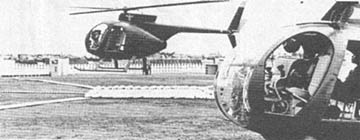 |
Page 8 TROPIC LIGHTNING NEWS February 24, 1969
Squashing
Charlie’s Hideouts Big Job For Rome Plows
CU CHI - One of the surest
ways to defeat an elusive enemy is to eliminate his hiding places.
During an 18-day operation
in the Citadel and An Phu areas northwest of Cu Chi, the 50lst Engineer Company
(Land Clearing) of the 62d Engineer Battalion cleared nearly 9,848 acres of
overgrown, enemy-infested land.
The task was accomplished by
Rome Plows - small bulldozer-like machines that cut down and plow under any
brush and trees that get in the way.
The Citadel, long-time haven
for the enemy and his equipment, consisted of vast overgrown hedgerows in which
crafty VC and NVA soldiers dug huge tunnel and bunker complexes.
The land clearing company
operated in three teams, each having nine plows and one bull blade (a plow
especially adapted to move large trees and heavy obstacles).
Maneuvering through dense
hedgerow complexes the plows are directed by First Lieutenant Kenneth Steen, Du
Mont, N.J., the company commander.
By radio, Steen directs the
plows’ movements by using identifying numbers stenciled on the cab.
Fire Brigade soldiers from
the 1st Battalion (Mechanized), 5th Infantry, and the 2d Battalion, 12th
Infantry, provided security for the engineers throughout the operation.
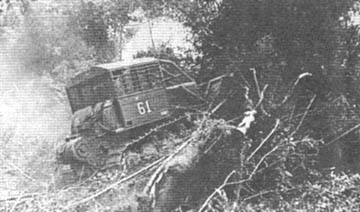 As the teams moved through
the area they destroyed 1,168 sniper holes and 902 bunkers along with 3,715
meters of trenchline and 1,150 meters of underground tunnels.
As the teams moved through
the area they destroyed 1,168 sniper holes and 902 bunkers along with 3,715
meters of trenchline and 1,150 meters of underground tunnels.
In the area there were
numerous weapons and munitions uncovered including 14 assorted “dud” rounds,
15 booby traps, 11 mines, 200 blasting caps and 7,340 assorted munitions rounds.
The Tropic Lightning
soldiers and the engineers also found more than 301,000 piasters of Charlie’s
money.
The project wasn’t
entirely destructive either. Constructive
plans are in the making to assist the villagers to develop and cultivate the
cleared land.
In 18 days, the 501st
Engineer Company and 2d Brigade soldiers eliminated many future hazards to
allied troops, disorganizing Charlie’s infiltration system and depriving him
of needed cover.
ROME
PLOWS (above)
working in the Tropic Lightning’s 2d Brigade area of operations flatten
trees and brush and continue to roll. (PHOTO
BY SP4 FRANK HEINY)
Manchu
MEDCAP Aids Cong Victims
By 1LT MACK D. GOODING
TAY NINH - Even as Division
combat troops were cornering an estimated VC company that brutally attacked two
pro-government hamlets 35 miles southeast of Tay Ninh, Tropic Lightning Civic
Action forces were helping the hamlets’ people start to rebuild.
Coordinating the civic
action work was Specialist 4 Lynn B. Johnson, Santa Cruz, Calif., who serves as
the NCOIC of the 4th Battalion, 9th Infantry Manchus S-5 (Civic Action Section).
He was already working to
find food for the refugees from Binh Hoa and Binh Thuan hamlets as elements from
the Manchus and 3d Squadron, 4th Cavalry, closed in on the hit-and-run Viet Cong
force. (They finally trapped the
Communists and killed 19 of them in an early morning battle).
The refugees were fleeing
from an attack that had left one of their hamlet chiefs dead and several entire
families slaughtered. They traveled
four miles to Go Dau Ha, which had also been hit by wanton VC mortar fire that
killed two small boys.
Go Dau Ha, however, was
protected from ground attack by a local ARVN force and Combined Reconnaissance
and Intelligence Patrol (CRIP). It
is also Johnson’s base of operation, so when 1,000 hungry refugees showed up
at an old Buddhist temple in the village, he was ready.
He collected food from the
CRIP and from MACV Advisory Team #33, which works with the Go Dau Ha ARVN force.
Before the day was out,
Johnson had also processed 11,000 pounds of food sent from Cu Chi by truck by
the Division Support Command and 500 pounds procured hastily by the Manchu mess
hall at Tay Ninh base camp and sent out with the CRIP resupply convoy.
With the help of a local Cao
Dai clergyman, Johnson distributed part of the food to refugees, many of whom
had already started back to rebuild their hamlets and trucked the rest to the
people who had stayed in Binh Hoa and Binh Thuan.
The next day, the 1st
Brigade troops mounted a MEDCAP (Medical Civic Action Program) right where it
was most needed - in Binh Hoa.
The Manchus’ veteran
MEDCAP leader, Specialist 5 Mike Devine, Girardville, Pa., treated 120 patients
in the place where people had learned the hard way how the Viet Cong treat
innocent civilians.
Returning to Tay Ninh he
enlisted the help of Private First Class William Bruce, Grafton, Wisc., the
Manchu headquarters company mail clerk, and obtained a ton of assorted dried
foods from the 1st Brigade headquarters.
ľ
Cav . . .
(Continued From Page 1)
the air. A piece of shrapnel cut
into Captain Moss’s back, but he shook the pain off and continued to give
commands into the radio.
A tank was hit by an RPG and
stopped in the middle of the trail, blocking the way for vehicles behind it.
Specialist 4 John Johnson of Philadelphia, Pa. and Private First Class Donald R.
Harris of West Point, Va., ran through the heaviest part of the fire and Johnson
drove the tank off the road while Harris directed him from the cupola.
Platoon Sergeant Samuel G. Jenkins of Quincy, Ill., continued pouring out
fire at an incredible rate.
First Lieutenant John R.
Moore of Orange Grove, Calif., commanding the first platoon, remained cool
throughout the battle, and thus helped to keep everyone else calm.
“Those were the guys who
really had to come through,” explained First Lieutenant Jerome Klar of San
Antonio, Texas, the forward observer. “The
only way to bust up an ambush is to overpower the enemy with fire.”
The heavy fighting ended
around 3:30 pm after the Cav troopers broke the back of the NVA defenses.
Forty-six enemy bodies were found. Several
AK47s, an RPG launcher, a machinegun with ammunition and hand grenades were
captured.
|
ON LINE
- Tropic Lightning soldiers of Bravo
Company, 2d Battalion, 14th Infantry assault suspected enemy
positions in a hedgerow near Duc Hoa. Three
suspected VC were detained during the encounter
(PHOTO BY SP4
E.R. JAMES)
|
 |
Thanks to
Mack D. Gooding, 15th PID, 1st Bde., for sharing this issue,
Kirk Ramsey, 2nd Bn., 14th Inf. for creating this page.
This page last modified 8-12-2004
©2004 25th Infantry Division Association. All rights reserved.